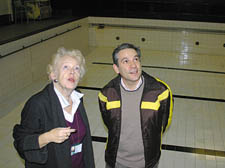|
|
 |
| |

Leisure chief Councillor Flick Rea and Ian Dungavell of the Victorian Society inspect the damage |
Pool shuts for £23m repair job
Behind-the-scenes photos show extent of decay as baths shut for three years
THE historic Prince of Wales Baths in Kentish Town will close in six weeks after further breakdowns forced the council to urgently bring forward refurbishment work.
It is expected to be closed for three years.
These behind-the-scenes photographs show for the first time the extent of the disrepair at the popular swimming pool in Prince of Wales Road, exposing the crumbling roof, broken pipes and generations of mould that clings to the walls.
Camden has been battling with boiler breakdowns at the baths for years but its final crisis point came last month when the learner pool failed.
Faced with a £300,000 repair bill just to fix the beginners’ pool, leisure chiefs have announced they will instead get started with their overall £23-million refurbishment earlier than expected.
It will be one of only two facelifts planned for London’s deteriorating Victorian pools.
Leisure chief Councillor Flick Rea said: “This is very much my baby. If it doesn’t come off then it will be my head on the line – but we can pull this off.
“I’m delighted that we are going ahead with the refurbishment. That is what people wanted. I think the strength of feeling for the baths wasn’t appreciated. People would grumble and mutter but it wasn’t until somebody said let’s do something about it, ‘lets knock it down’, that there was uproar and people said ‘no, don’t do it’.”
During a backstage tour on Monday afternoon, Cllr Rea revealed the damage in a maze of tunnels running beneath the pool.
At one stage, she was confronted with a burst pipe apparently plugged by a rag.
She described weeds growing in the eaves as ‘the hanging gardens of Babylon’ and pointed out the hazard tape and holes in the roof. Some of the areas are so unsuitable for public use that they are likely to be completely mothballed, the Town Hall said.
The 100 year-old pool will close on February 25 and work will begin soon after that.
Cllr Rea added: “There is a contingency for this project. We don’t know what we will find when we start work but I don’t want to have to go back to my colleagues and say that ‘it’s going to cost a bit more, can you spare another £2 million’ or so on.
“We can’t possibly give a time for how long it will take but the earlier we start, the earlier we will get it open again.”
The council has circulated artists’ impressions of how the refurbished complex will look but insists that all ideas are welcome during a six-week public consultation on how the project should look.
The refurbishment turned into a fractious election issue last May when Labour councillors lost their seats in Kentish Town as council chiefs dithered over how the pool could be saved.
At the time, there were no guarantees made over the future of the baths and the Town Hall considered closing the pool and starting from scratch with a new facility at nearby Talacre Sports Centre in Dalby Street.
Camden has now agreed to splash out £23 million to restore two main pools and the learner pool.
Cllr Rea said: “I’m not putting the blame on any previous administration.
“Victorian pools have been neglected across the country. Hopefully, we are doing something different and unique by trying to save the building.”
The council has the support of Dr Ian Dungavell, director of the Victorian Society, one of the campaigners who fought to keep it open.
He said that Camden was going against national trends in trying to restore the baths.
Dr Dungavell said: “It is nice that I don’t have to keep writing nasty letters to the council. We fully support the attempts to refurbish the building.”
He said that Culture Secretary Tessa Jowell should take a stronger role in saving Victorian pools, adding: “The Department of Culture, Media and Sport (DCMS) is good at supporting Olympic size pools but not all of us are Olympic swimmers.
“They should help with community pools too but there is no statutory obligation for any council to provide swimming and it has been left to the local authorities to decide what they want to do with their pools.”
|
 |
|
 |
|